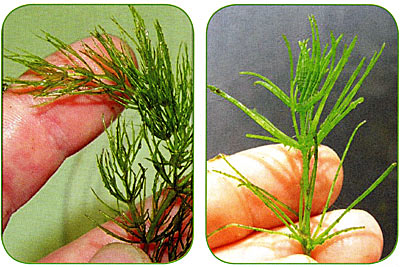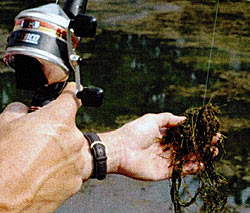
David Letterman's Late Show was famous for its "Top Ten" comedy bit. Not sure if Letterman ever dealt with runaway aquatic plants, but I have. After almost three decades working with people to manage unwanted pond greenery, I've come up with a list of the top ten mistakes people make when self-treating their plants. This list should be much longer, but we've only got a few pages to share information.
Commercial lake management companies can attest that it is anything but easy. They earn their livings by avoiding the hard lessons they've learned over the years while battling aquatic weeds. How can we expect John Q. Pondmeister to know?
Mistake #1 Failure to recognize plant species that could become a problem. Not all plants are invasive. Identifying plants and understanding their potential during early growth stage could be the difference between prevention and expensive treatment. At the least, you'll know whether you have plants you want to allow to grow, or eradicate early on.
Identification of plants is crucial. A perfect example of a very common mistake is coontail compared to Chara. While these two plants may look similar to a novice, they are far from it. Coontail requires an herbicide. But, Chara is an algae species. Chara responds to an algaecide, not an herbicide.
Texas A&M has their Aquaplant website, which is outstanding. There are books and card decks available as well. Pond Boss sells a couple of those on their website. Properly identify your plants.
Mistake #2 Failure to proactivelv monitor for problems. This goes hand in hand with identifying plants. If pondmeisters don't watch growth and monitor the spread of plants, it can be a matter of a few short weeks before plants can go from seemingly nothing to a major headache. Consistently monitoring your pond, especially during those prime spring and early summer months, is a key to keeping unwanted, invasive plants at bay.
Don't be fooled just because you can't see the plants. They may be just a few feet off the bottom, in deeper water than you expect. Good sonar units can detect and quantify. But, so can a heavy hook on the end of twenty-pound test monofilament fishing line. Take hydrilla, for example. It may be six or seven feet below the surface, but it grows 5-8 inches—every day. If you don't identify it, and then wait three weeks, you'll have an expanding mat of plants that will cover most of your pond—if you have hydrilla.
Mistake #3 Failure to consider all management options. People often automatically turn toward the use of herbicides, presuming they're the Silver Bullet for their weed problems. In some cases, herbicides may BE the best option, but they should never be viewed as the De Facto remedy for all aquatic weed infestations. Instead, herbicides should be considered as one of the potential tools in an overall weed management program. In most cases, herbicides ALONE are rarely a long-term solution for most aquatic weed problems. Remember, aquatic plants need three fundamentals to grow: temperature, nutrients, and sunlight. Even if you take out plants with herbicides, something else will grow if these three basics come together.
Several other weed management options certainly exist, and each should be considered for its potential merits—regardless of whether herbicide treatments are also used. Physical removal is an option. So are triploid grass carp, for certain species of plants.
I've seen numerous cases where herbicides were used in conjunction with other weed management techniques to accomplish long-term benefits towards a pond's primary purpose.

Mistake #4 Not selecting the appropriate herbicide. There are several aquatic herbicides on the market. Some are older chemistries while others possess newer technologies. Whether old or new, each herbicide generally has its best fit within a specific range of circumstances. When considering herbicide-options, the first obvious factor to determine is whether the product will control the offending weed species.
Secondly, will it function properly under the pond's unique site-parameters?
One of the most important variables for herbicide selection involves the stability of the pond's water. Basically, you need to ask, "Is the water static (or stationary) for long periods, or does it frequently transition (or discharge) due to rain-events or other influences?" The advantage of contact herbicides is the short contact time they require to accomplish their mode-of-action; which is often measured in minutes. That's why contact herbicides are better suited to sites or conditions where prolonged plant-contact is unlikely or impossible.
Contact herbicides usually provide very quick visual results; sometimes within only an hour or two. But, since they only affect the contacted portions of the plant, their ability to control root-structures is very limited, which allows some treated plants to regrow after receiving an herbicide haircut.
On the other hand, systemic herbicides have a completely different mode-of-action. Again, in very general terms, systemic herbicides enter through leaf contact, and sometimes roots, and then move within the plant's vascular system— either the xylem or phloem, or both—where they disrupt various physiological functions that occur only in plants. In most cases, these interrupted functions involve the plant's ability to produce nutrients for itself. In essence, the plant succumbs to malnutrition.
Selecting the appropriate herbicide mode-of-action, especially when targeting submerged weed species, is greatly determined by the owner's ultimate objective.
If the objective is to simply target specific areas of subsurface weeds within a lake or pond, then contact herbicides are generally the best option. If controlling submerged weed growth throughout the entire water body is the objective, then a systemic mode-of-action usually offers the most efficiency, but not always—especially if uncontrolled transitioning water is a factor.
Mistake #5 Not recognizing plant maturity factors. Cattails are an excellent example, since they're a common pest for many pond-owners. Treating cattails too early in the season, like when they first appear in the spring, will generally provide poor results. The plant simply isn't in the proper phase of its annual growth-cycle for most herbicides' mode-of-action to function properly. At the opposite extreme, treating cattails too late—after they've begun the process of going dormant for the winter—will yield the same poor results. With any given plant and herbicide treatment, make sure the plant's level of maturity is in your favor.
Mistake #6 Failure to evaluate "cost" in its proper context. Number 6 is such a common mistake that it should be placed as #1. It involves the inability to evaluate an herbicide treatment's true cost from a long-term perspective. So many phone calls and emails begin with the question, " What is the best and cheapest herbicide that I can use to kill XYZ-weed in my lake, FOREVER?" First of all, there aren't any cheap treatments in my book. However, there are varying degrees of cost effective treatments.
Ultimately, the cost-effectiveness of a treatment is a factor of its cost relative to the length of control that it provides.
Mistake #7 Failure to use appropriate application equipment and application techniques. This is another huge challenge for Do-it-Yourself applicators. Not having the proper equipment to properly apply an herbicide often leads to failure, even if the application rates are adequate. Proper technique and proper equipment are crucial to success.
Mistake #8 Not accurately measuring treatment areas. Mistake number eight centers around the pond owner's inaccuracy when measuring his pond—or a treatment area within a pond. A close estimate is sometimes okay, but I can't count the number of times when a so-called 1-acre pond turned out to be one-half acre; or in some cases 2 acres.
Depending on the problem weed—and the selected product—an inaccurate measurement of the pond may mean the difference between success and failure
Mistake #9 Not applying the proper dosage or concentration Number 9 ties directly in with number 8, and several of the previous mistakes for that matter. Failure to use the proper herbicide dosage or concentration is a sure bet for poor results.
I'll bet that most think I'm referring to using too small of a dose or concentration, right? Not so fast! With many pond owners—and homeowners for that matter—there's a common misperception that if a little will work, more will work even better.
Folks! You can only kill something so dead!
Remember Mistake #4? Anyone? It involved selecting an herbicide with the proper mode-of-action. Particularly with systemic herbicides, using too high of a concentration can actually cause poor results, especially in respect to root-control, since the herbicide's normal mode-of-action may be nullified if the plant's transport system immediately shuts down after treatment due to an herbicide overdose.
In the same respect, an herbicide's mode-of-action may be hampered by using too low of a dose. Remember that the most expensive herbicide treatments are those that fail to perform as expected. Always read the label—and consult with a qualified resource for clarification. Labels are often confusing, especially those that refer interchangeably to using a %-solution of mixture or a rate-per-acre.
Many herbicides stipulate the use of a surfactant, or wetting agent. Some people choose to
Mistake #10 Failure to moderate treatment aggressiveness In the absence of pro-active monitoring, weeds can get out of hand in a hurry. Say, the pondmeister decides to have a party out by the pond, but certainly not with all those nasty weeds that he's been ignoring all spring, so he decides to get aggressive with a corrective treatment—in July, August, or September.
This is a recipe for disaster! Think FISH KILL. Too much, too fast, in hot water leads to rapid degradation of dead plants, water quality suffers, oxygen levels plummet, and fish die. Not a pretty sight for that party—or wedding. Monitor earlier, much earlier.
So, there you have it. Oh yes, there's more, much more. But, this list is enough to help guide you through to a successful plant management thought process.
This list may not be quite as funny as David Letterman's Top 10 was, but dealing with aquatic plants in your favorite waters probably isn't too funny, either.
Reprinted with permission from Pond Boss Magazine



